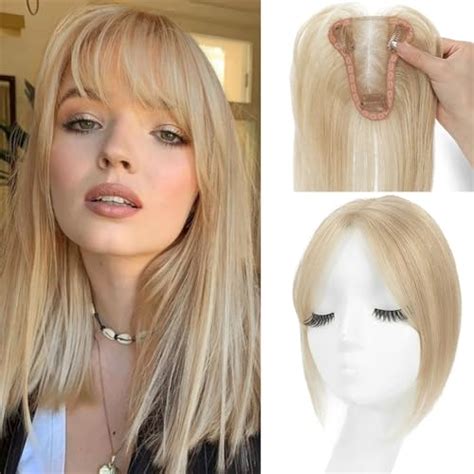Hair toppers for women are in high demand for several reasons:

- Hair loss and thinning: According to the American Hair Loss Association, over 50% of women experience some degree of hair loss or thinning by the age of 50.
- Medical conditions: Cancer treatments, alopecia, and other medical conditions can lead to hair loss, affecting confidence and well-being.
- Aging: Hair naturally thins and becomes finer with age, resulting in a loss of volume and luster.
Covering up hair loss and thinning is a common motivation for women seeking hair toppers. Here’s how they can transform lives:
Confidence Boosters
Hair toppers provide an instant confidence boost by concealing areas of thinning hair. They allow women to feel more secure and attractive, empowering them to participate in social activities without feeling self-conscious.
“I was so embarrassed about my hair loss. I avoided social events and felt like I couldn’t be myself,” said Sarah, a hair topper user. “After I started wearing a topper, I felt like a weight had been lifted. I could finally focus on the things I enjoyed instead of worrying about my hair.”
Hair Enhancement
Hair toppers not only cover thinning areas but also enhance the overall appearance of hair. They add volume, length, and texture, giving women the opportunity to experiment with different styles and colors.
“I’ve always dreamed of having long, thick hair. But I never thought it was possible because my hair was so thin,” said Emily, another hair topper user. “My topper gave me the hair I’ve always wanted. I feel so confident and beautiful when I wear it.”
Scalp Protection
Hair toppers can also act as a protective layer for the scalp, shielding it from environmental damage and sun exposure. This is especially beneficial for women who have experienced hair loss due to medical treatments or who have sensitive scalps.
“My scalp was very sensitive after my cancer treatments. I couldn’t tolerate harsh shampoos or styling products,” said Julia, a breast cancer survivor. “My hair topper protected my scalp and allowed it to heal while still giving me the appearance of full hair.”
Types of Hair Toppers
Hair toppers come in a variety of styles, colors, and lengths to meet individual needs:
- Partial toppers: Cover specific areas of hair loss or thinning
- Full toppers: Provide complete coverage from the crown to the nape of the neck
- Clip-in toppers: Quick and easy to put on and take off
- Tape-in toppers: Long-lasting and secure, but require professional application
Benefits of Hair Toppers
- Instant gratification: Provides immediate coverage and enhancement
- Non-surgical solution: Avoids the risks and costs associated with hair transplant surgery
- Versatile: Can be styled and colored to match existing hair
- Affordable: More cost-effective than other hair loss treatments
- Comfortable to wear: Made from high-quality materials for breathability and secure hold
Tips and Tricks
- Choose the right color and texture: Match the topper to your natural hair as closely as possible for a seamless blend.
- Prepare your hair: Clean and style your hair before applying the topper to ensure a secure grip.
- Apply the topper: Use clips or tape to attach the topper securely to your hair.
- Blend it in: Use a brush or comb to gently blend the topper with your natural hair.
- Style it: Cut, color, or style the topper to match your desired look.
Pros and Cons
Pros:
- Instant hair coverage and enhancement
- Non-surgical solution
- Versatile and affordable
- Comfortable to wear
Cons:
- Requires maintenance (washing, styling)
- May not be suitable for all hair types and conditions
- Some toppers may be vulnerable to tangling or shedding
Innovative Applications
The versatility of hair toppers opens up new possibilities for creative hair transformations:
Fill in hair extensions: Add volume and length to existing hair extensions.
Create temporary hairstyles: Experiment with different colors and textures for special occasions.
Cover up roots: Conceal the appearance of roots between hair color appointments.
Repair damaged hair: Use toppers to cover up broken, split ends, or damaged areas of hair.
Comparison Table of Hair Topper Types
| Type | Coverage | Attachment | Maintenance |
|---|---|---|---|
| Partial | Specific areas | Clips or tape | Lower |
| Full | Crown to nape | Clips, tape, or fusion | Higher |
| Clip-In | Quick and easy | Clips | Lower |
| Tape-In | Long-lasting | Tape | Higher |
Comparison Table of Hair Topper Attachment Methods
| Method | Security | Comfort | Durability |
|---|---|---|---|
| Clips | Easy to apply | Comfortable | Less secure than tape |
| Tape | Long-lasting | More secure than clips | Can damage hair if not applied properly |
| Fusion | Permanent | Most secure | Can be uncomfortable |
Conclusion
Hair toppers for women empower individuals to regain confidence, enhance their physical appearance, and protect their scalp from environmental damage. With a variety of styles, colors, and types to choose from, hair toppers offer a non-surgical solution to hair loss and thinning. By considering the benefits, tips, and tricks, individuals can find the perfect topper to transform their hair and boost their self-esteem.
